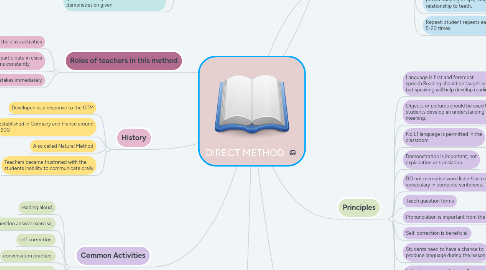DIRECT METHOD
by Alejandro Martinez Acevedo

1. Disadvantages
1.1. The assumption that a second language can be learnt in exactly the same way as a first, when in fact the conditions under which a second language is learnt are very different.
1.2. Fell short from fulfilling the needs of educational systems
1.3. It was hard for public schools to integrate it
2. History
2.1. Developed as a response to the GTM
2.2. Established in Germany and France around 1900
2.3. Also called Natural Method
2.4. Teachers became frustrated with the students inability to communicate orally
3. Common Activities
3.1. reading aloud,
3.2. question answer exercise,
3.3. self correction,
3.4. conversation practice,
3.5. fill-in-the-blank exercise,
3.6. dictation
3.7. and paragraph writing.
4. Roles of teachers in this method
4.1. Direct the class activities
4.2. Encourage students to participate in class by asking them questions constantly
4.3. Corrects their mistakes immediately
5. Role of students in this method
5.1. The teacher and the students are more like partners in the teaching/learning process.
5.2. The students’ role in direct method is the active learner
5.3. They are active in exploring new words, expression, etc. in target language
5.4. The students are also the observer and practitioner.
5.5. Students observe the target language used by the teacher in teaching and they try to get the meaning based on the demonstration given
6. Characteristics
6.1. Show: point to visual aid or gestures (for verbs), to ensure student clearly understands what is being taught.
6.2. Say: teacher verbally introduces element, with care and enunciation.
6.3. Try: student makes various attempts to pronounce new element.
6.4. Mold: teacher corrects student if necessary, pointing to mouth to show proper shaping of lips, tongue and relationship to teeth.
6.5. Repeat: student repeats each element 5-20 times.
7. Principles
7.1. Language is first and foremost speech.Reading should be taught early, but speaking will help develop reading.
7.2. Objects or pictures should be used to help students develop an understanding of meaning.
7.3. No L1 language is permitted in the classroom.
7.4. Demonstration is important, not explanation or translation.
7.5. DO not memorise word lists- Use new vocabulary in complete sentences.
7.6. Teach question forms
7.7. Pronunciation is important from the start.
7.8. Self-correction is beneficial.
7.9. Students need to have a chance to produce language during the lesson.
7.10. Inductive grammar is best. Grammar rules are not important.
7.11. Teach writing early in the lessons.
7.12. Topic based learning or functional scenarios are used to develop a syllabus.
7.13. Culture of the target language group is an important inclusion in the lesson
8. Advantages
8.1. It is a natural method which teaches language the same way the mother tongue is acquired
8.2. Its emphasis on speech made it more attractive for those who have needs of real communication in the target language.
8.3. It was one of the first methods to introduce the teaching of vocabulary through realia


